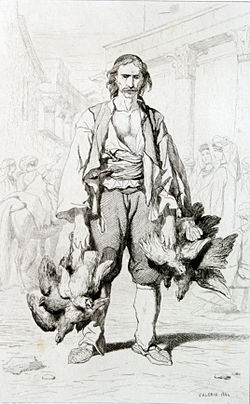
Back Morlacos AN Morlacs Catalan Maurowalachen German Morlacos Spanish Morlaci Croatian Morlákok Hungarian Morlacchi Italian Morlachowie Polish Caravlahi Romanian Морлахи Russian

Morlachs (Serbo-Croatian: Morlaci, Морлаци or Crni Vlasi, Црни Власи; Italian: Morlacchi; Romanian: Morlaci) has been an exonym used for a rural Christian community in Herzegovina, Lika and the Dalmatian Hinterland. The term was initially used for a bilingual Vlach pastoralist community in the mountains of Croatia from the second half of the 14th until the early 16th century. Then, when the community straddled the Venetian–Ottoman border until in the 17th century, it referred only to Slavic-speaking, mainly Eastern Orthodox but also Roman Catholic people. The Vlach, i.e., Morlach, population of Herzegovina and Dalmatian hinterland from the Venetian and Turkish side were of either Roman Catholic or Christian Orthodox faith.[1] Venetian sources from 17th and 18th centuries make no distinction between Orthodox and Catholics, they refer to both groupings as Morlachs.[2] The exonym ceased to be used in an ethnic sense by the end of the 18th century, and came to be viewed as derogatory, but has been renewed as a social or cultural anthropological subject. As the nation-building of the 19th century proceeded, the Vlach/Morlach population residing with the Croats and Serbs of the Dalmatian Hinterland espoused either a Serb or Croat ethnic identity, but preserved some common sociocultural outlines.
- ^ Davor Dukić; (2003) Contemporary Wars in the Dalmatian Literary Culture of the 17th and 18th Centuries p.132; Journal of Ethnology and Folklore Research (0547–2504) 40 [1]
- ^ MILE BOGOVIĆ, Katolička crkva i pravoslavlje u Dalmaciji za mletačke vladavine, Analecta croatica christiana 14, drugo izdanje, Zagreb, 1993 https://www.scribd.com/doc/225038576/15465505-Mile-Bogovic-Katolicka-Crkva-i-Pravoslavlje-u-Dalmaciji #page= 14-17
© MMXXIII Rich X Search. We shall prevail. All rights reserved. Rich X Search